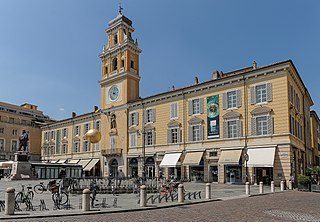
Parma is a city in the northern Italian region of Emilia-Romagna known for its architecture, music, art, prosciutto (ham), cheese and surrounding countryside. With a population of 198,292 inhabitants, Parma is the second most populous city in Emilia-Romagna after Bologna, the region's capital. The city is home to the University of Parma, one of the oldest universities in the world. Parma is divided into two parts by the stream of the same name. The district on the west side of the river is Oltretorrente. Parma's Etruscan name was adapted by Romans to describe the round shield called Parma.

Piacenza is a city and comune (municipality) in the Emilia-Romagna region of Northern Italy, and the capital of the eponymous province. As of 2022, Piacenza is the ninth largest city in the region by population, with more than 102,000 inhabitants.

GiacomoBarozzida Vignola, often simply called Vignola, was one of the great Italian architects of 16th century Mannerism. His two great masterpieces are the Villa Farnese at Caprarola and the Jesuits' Church of the Gesù in Rome. The three architects who spread the Italian Renaissance style throughout Western Europe are Vignola, Serlio and Palladio. He is often considered the most important architect in Rome in the Mannerist era.

The House of Farnese was an influential family in Renaissance Italy. The titles of Duke of Parma and Piacenza, Duke of Latera and Duke of Castro were held by various members of the family.

Farfa Abbey is a territorial abbey in northern Lazio, central Italy. In the Middle Ages, it was one of the richest and most famous abbeys in Italy. It belongs to the Benedictine Order and is located about 60 km (37 mi) from Rome, in the comune (municipality) of Fara Sabina, of which it is also a frazione (hamlet).
Cortemaggiore is an Italian comune located in the Province of Piacenza. Cortemaggiore is located in northern Italy about 80 kilometres (50 mi) from Milan and 120 kilometres (75 mi) from Bologna, in the Pianura Padana. The municipality borders Fiorenzuola d'Arda, Villanova sull'Arda, Besenzone, San Pietro in Cerro, Caorso, Pontenure and Cadeo.

The Shrine of Santa Maria della Steccata is a Greek-cross design Renaissance church in central Parma, Italy. The name derives from the fence in the church. A Nursing Madonna is enshrined within, crowned on 27 May 1601 by a Marian devotee, Fray Giacomo di Forli of the Capuchin order. Pope Benedict XVI raised the Marian sanctuary to the status of Basilica minor on 9 February 2008.
Antonio Brianti was an Italian architect, active mainly in his native Parma.
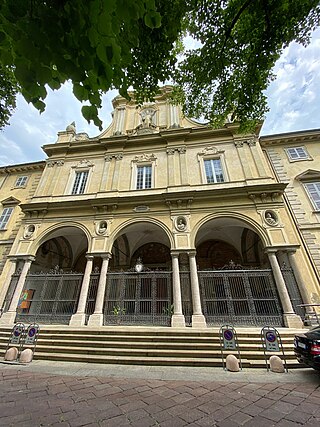
The Basilica of San Savino is an ancient Roman Catholic basilica in the city of Piacenza in the Province of Piacenza, Italy. It is dedicated to Saint Sabinus of Piacenza, second bishop of the city.
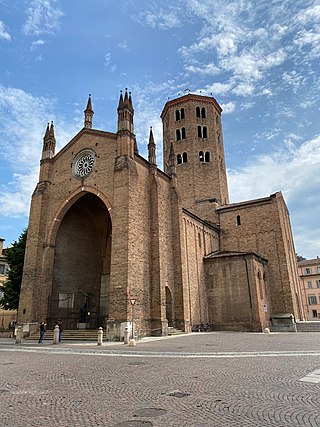
The Basilica of Sant'Antonino is a medieval Roman Catholic basilica in the city of Piacenza in Italy. it is dedicated to the patron saint of the city, Antoninus.
Giovanni Evangelista Draghi (1654–1712) was an Italian painter of the late-Baroque or Rococo period. Luigi Lanzi erroneously refers to him as Giovanni Battista Draghi, who should not be confused with the composer of the same name.

San Francesco is a Roman Catholic church, located on Piazza Cavalli #68 in Piacenza, Italy. It was built in a style described as Lombard Gothic and is centrally located facing towards the Piazza del Cavalli, which is surrounded by the Palazzo Gotico and the Palazzo del Governatore.
San Sepolcro is a Renaissance style, Roman Catholic church and convent, located in Piacenza, Italy.

Sant'Agostino is a Renaissance style, former Roman Catholic church, located at the intersection of the Avenue Farnese and via Giordani in Piacenza, region of Emilia Romagna, Italy.
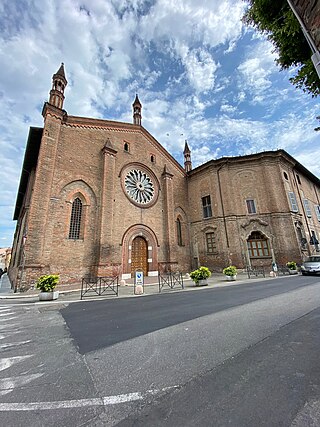
Sant'Anna is a Gothic style, Roman Catholic parish church, located at Via Scalabrini #83 in Piacenza, Region of Emilia Romagna, Italy.
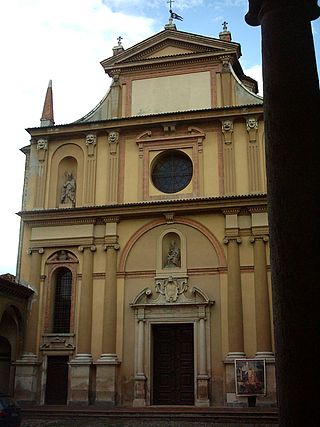
San Sisto is a Renaissance style, Roman Catholic church, located on the Via of the same name in north-central Piacenza, Region of Emilia Romagna, Italy.

The Gazzola Institute is a school of the arts and art museum, located on via Gazzola n°9 in the town of Piacenza, region of Emilia Romagna, Italy.

The Santissima Annunziata, also called the Basilica del Paradiso, is a Renaissance style, Roman Catholic church and convent located on Via Massimo D'Azeglio in Parma, Italy.
The following is a timeline of the history of the city of Piacenza in the Emilia-Romagna region of Italy.
Domenico Valmagini (1677–1730) was an Italian architect and engineer, active in a Baroque style in the Duchy of Parma and in Lombardy. After the death of Giovanni Battista Barattieri, Domenico was appointed the main court architect for Ranuccio II. In 1695, he was replaced by the brothers Galli Bibiena at the behest of the new Duke Francesco Farnese.

















